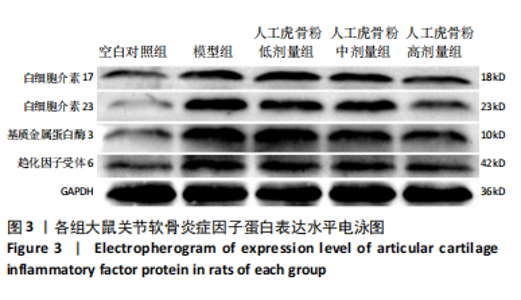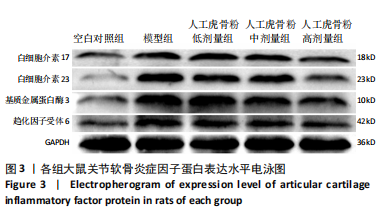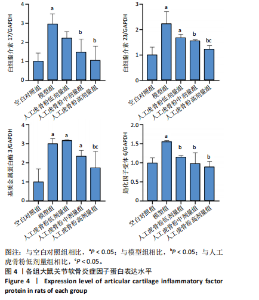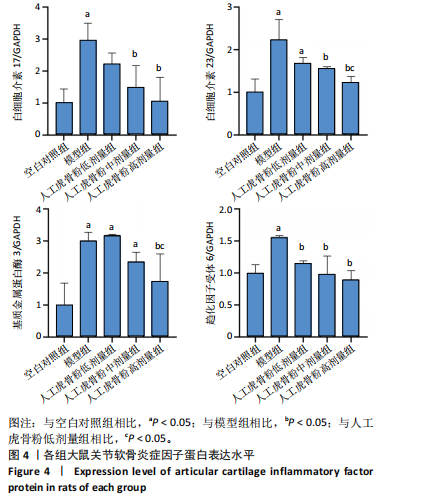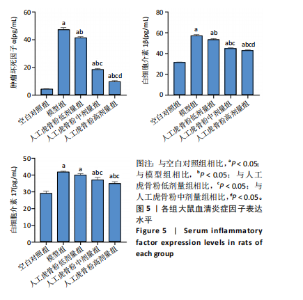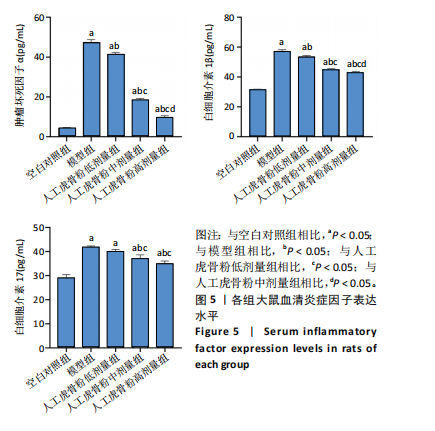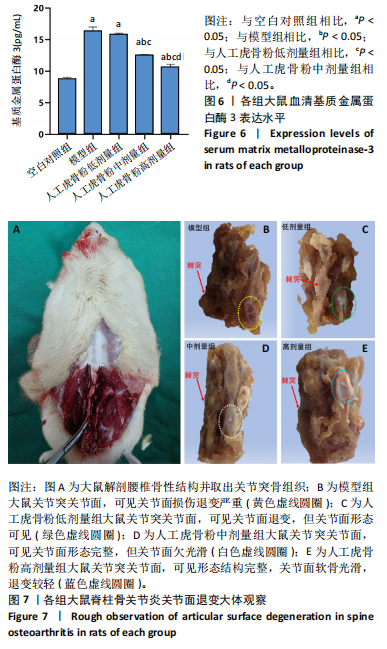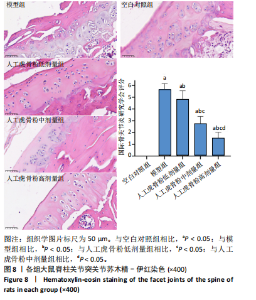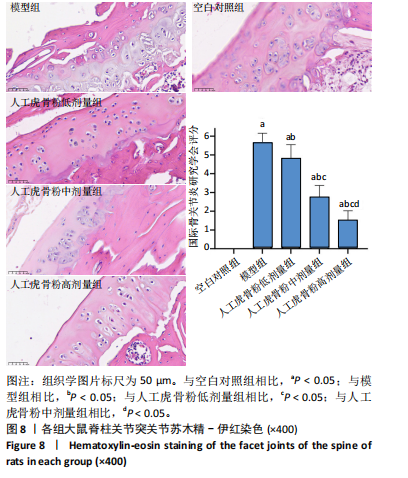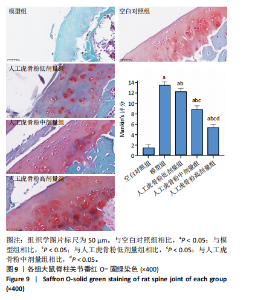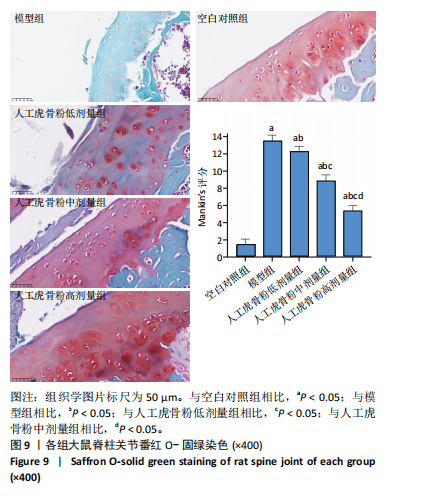Chinese Journal of Tissue Engineering Research ›› 2025, Vol. 29 ›› Issue (26): 5511-5519.doi: 10.12307/2025.778
Previous Articles Next Articles
Artificial tiger bone meal improves degeneration of spinal facet joints and immune microenvironment of articular cartilage in rats with spine osteoarthritis
Li Wen1, Zhao Jingyi1, Hu Wen1, Xiong Bin1, Tang Chao2
- 1Southwest Medical University, Luzhou 646000, Sichuan Province, China; 2Department of Orthopedics, Affiliated Hospital of Southwest Medical University, Luzhou 646000, Sichuan Province, China
-
Received:2024-07-22Accepted:2024-09-21Online:2025-09-18Published:2025-02-20 -
Contact:Tang Chao, Doctoral candidate, Attending physician, Department of Orthopedics, Affiliated Hospital of Southwest Medical University, Luzhou 646000, Sichuan Province, China -
About author:Li Wen, Southwest Medical University, Luzhou 646000, Sichuan Province, China
CLC Number:
Cite this article
Li Wen, Zhao Jingyi, Hu Wen, Xiong Bin, Tang Chao. Artificial tiger bone meal improves degeneration of spinal facet joints and immune microenvironment of articular cartilage in rats with spine osteoarthritis[J]. Chinese Journal of Tissue Engineering Research, 2025, 29(26): 5511-5519.
share this article
Add to citation manager EndNote|Reference Manager|ProCite|BibTeX|RefWorks
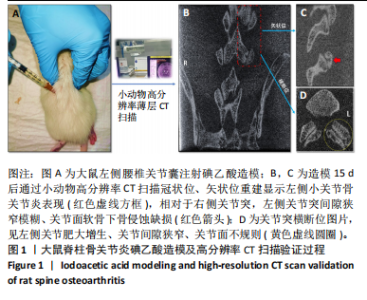
2.1 实验动物数量分析 共纳入60只大鼠,48只大鼠经脊柱骨关节炎造模后均存活,其中43只大鼠攀爬跳跃活动减退,造模15 d后通过小动物高分辨率CT下可见骨关节炎改变,造模成功率为90%,5只大鼠未见明确脊柱骨关节炎表现(模型组2只、低剂量组1只、中剂量组1只、高剂量组1只)。空白对照组12只完全存活。 2.2 人工虎骨粉对大鼠脊柱关节软骨中炎症因子表达水平的影响 与空白对照组相比,模型组大鼠软骨组织IL-17、IL-23、MMP-3、CCR-6水平显著升高(P < 0.05),人工虎骨粉低剂量组大鼠软骨组织IL-23和MMP-3水平显著升高(P < 0.05),中剂量组大鼠软骨组织MMP-3水平显著升高(P < 0.05),高剂量组大鼠与空白对照组无统计学差异(P > 0.05);与模型组相比,人工虎骨粉低剂量组大鼠软骨组织CCR-6水平显著降低(P < 0.05),中、高剂量组大鼠软骨组织IL-17、IL-23、CCR-6显著降低(P < 0.05),高剂量组MMP-3显著降低(P < 0.05);与人工虎骨粉低剂量组相比,高剂量组大鼠软骨组织IL-23、MMP-3水平显著降低(P < 0.05),中剂量组IL-17、IL-23、MMP-3、CCR-6无明显统计学差异(P > 0.05),高剂量组IL-17、CCR-6无统计学差异(P > 0.05);与人工虎骨粉中剂量组相比,高剂量组IL-17、IL-23、MMP-3、CCR-6无统计学差异(P > 0.05),见图3,4。 2.3 人工虎骨粉对骨关节炎大鼠血清细胞因子的影响 如图5所示,与空白对照组比较,模型组和人工虎骨粉不同剂量组大鼠血清TNF-α、IL-1β和IL-17水平均显著升高(P < 0.05)。与模型组比较,人工虎骨粉低剂量组血清TNF-α、IL-1β水平显著下调(P < 0.05),人工虎骨粉中、高剂量组血清TNF-α、IL-1β和IL-17水平显著下调(P < 0.05), 而人工虎骨粉低剂量组血清IL-17相较模型组无统计学差异(P > 0.05)。与人工虎骨粉低剂量组比较,中、高剂量组血清TNF-α、IL-1β和IL-17水平显著下调(P < 0.05)。与人工虎骨粉中剂量组比较,高剂量组TNF-α、IL-1β水平显著下调(P < 0.05),而高剂量组血清IL-17相较中剂量组无统计学差异(P > 0.05)。 2.4 人工虎骨粉对骨关节炎大鼠血清MMP-3的影响 如图6所示,MMP-3在各造模组大鼠中高表达,与空白对照组相比差异有显著性意义(P < 0.05)。与模型组比较,人工虎骨粉中、高剂量组血清MMP-3水平显著下调(P < 0.05),而低剂量组效果有限,相较模型组未见统计学差异(P > 0.05)。与低剂量组比较,人工虎骨粉中、高剂量组血清MMP-3水平显著下调(P < 0.05)。与中剂量组比较,高剂量组血清MMP-3水平显著下调(P < 0.05)。 2.5 人工虎骨粉对大鼠脊柱关节病理变化的影响 2.5.1 大鼠脊柱关节苏木精-伊红染色 所有最终进入研究的大鼠采用0.3%戊巴比妥钠腹腔麻醉后脱臼处死后,取出各组大鼠腰椎及小关节组织,观察腰椎关节突的关节面退变情况,见图7。组织切片行苏木精-伊红染色,光镜下观察滑膜增生和炎症细胞浸润情况、骨和软骨破坏情况等病理学变化。如图8所示,在空白对照组中,大鼠关节腔面光滑,软骨表面平滑光整,结构清晰可见,滑膜组织形态正常,滑膜组织细胞排列较整齐,滑膜中没有观察到炎症细胞的浸润;而模型组关节结构和形态严重受损,关节表面凹凸不平,软骨细胞排列混乱,存在明显的软骨和骨破坏,滑膜中有大量炎症细胞聚集和浸润,上皮表面粗糙;人工虎骨粉低剂量组中,滑膜中炎症细胞的浸润及滑膜增生情况较模型组有所改善,但仍存在较为明显的软骨破坏现象;人工虎骨粉中、高剂量组较模型组关节炎症状改善显著,关节结构和形态较模型组正常,滑膜中存较少炎症细胞浸润,滑膜增生轻微,无明显的软骨损伤现象。 大鼠脊柱关节组织病理炎症国际骨关节炎研究学会评分显示:与模型组相比,人工虎骨粉各剂量组的病理炎症评分均有下降,人工虎骨粉各剂量组对大鼠脊柱关节炎症具有显著的改善作用,相较模型组差异有显著性意义(P < 0.05)。 2.5.2 大鼠脊柱关节番红O-固绿染色 对各组大鼠脊柱关节组织切片行番红O-固绿染色,光镜下观察大鼠脊柱关节软骨损伤情况和软骨下骨形态,红染部分为软骨基质,蓝绿色为骨组织。如图9所示,在空白对照组中大鼠脊柱关节软骨结构正常,表面光整,软骨细胞排列整齐,"
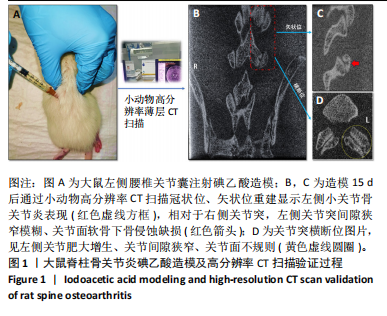
| [1] 李锋,宋跃明,方忠,等.脊柱小关节骨关节炎诊治专家共识[J].骨科,2018,9(6):417-422. [2] 包黎莎,王华芳,杨锦荧,等.人参总皂苷对大鼠骨关节炎的作用[J].浙江临床医学,2021,23(1):4-7 [3] 谭利贤,杜小康,汤润民, 等.脊柱小关节骨关节炎的病因/病理与发病机制研究进展[J].中国脊柱脊髓杂志,2022,32(10):954-960. [4] LINDSEY T, DYDYK AM. Spinal Osteoarthritis. 2023. In: StatPearls [Internet]. Treasure Island (FL): Stat Pearls Publishing, 2024. [5] GBD 2021 LOW BACK PAIN COLLABORATORS. Global, regional, and national burden of low back pain, 1990–2020, its attributable risk factors, and projections to 2050: a systematic analysis of the Global Burden of Disease Study 2021.Lancet Rheumatol. 2023;5:e316-e329. [6] MARCH LM, BACHMEIER CJ. Economics of osteoarthritis: a global perspective. Baillieres Clin Rheumatol. 1997;11(4):817-834. [7] MARTEL-PELLETIER J, BARR AJ, CICUTTINI FM, et al. Osteoarthritis. Nat Rev Dis Primers. 2016;2:16072. [8] 邹明,张红梅,徐艺筝.膝关节炎患者关节置换术后细菌感染严重程度与IL-1β、TNF-α、IL-6水平的相关性[J].中国微生态学杂志, 2020,32(1):44-46. [9] LI H, TSOKOS GC. IL-23/IL-17 Axis in Inflammatory Rheumatic Diseases. Clin Rev Allergy Immunol. 2021;60(1):31-45. [10] SCHINOCCA C, RIZZO C, FASANO S, et al. Role of the IL-23/IL-17 Pathway in Rheumatic Diseases: An Overview. Front Immunol. 2021;12:637829. [11] BUNTE K, BEIKLER T. Th17 Cells and the IL-23/IL-17 Axis in the Pathogenesis of Periodontitis and Immune-Mediated Inflammatory Diseases. Int J Mol Sci. 2019;20(14):3394. [12] XIAO J, ZHANG P, CAI FL, et al. IL-17 in osteoarthritis: A narrative review. Open Life Sci. 2023;18(1):20220747. [13] 李泽琴,杨佳明,高峰,等. 间充质干细胞促进软骨修复治疗骨关节炎的机制及应用进展[J]. 山东医药,2023,63(22):86-90. [14] ZHU X, SANG L, WU D, et al. Effectiveness and safety of glucosamine and chondroitin for the treatment of osteoarthritis: a meta-analysis of randomized controlled trials. J Orthop Surg Res. 2018;13(1):170. [15] SELIG DJ, KRESS AT, HORTON IM, et al. Pharmacokinetics, safety and efficacy of intra-articular non-steroidal anti-inflammatory drug injections for the treatment of osteoarthritis: A narrative review. J Clin Pharm Ther. 2022;47(8):1122-1133. [16] SKOU ST, ROOS EM. Physical therapy for patients with knee and hip osteoarthritis: supervised, active treatment is current best practice. Clin Exp Rheumatol. 2019;37 Suppl 120(5):112-117. [17] 王彦艳,姚梁怡,蔡立柏, 等.膝骨关节炎非手术治疗患者运动干预的最佳证据总结[J].护理学杂志,2024,39(8):102-106. [18] 刘潞兴,狄鸣远,杨强.中药有效成分治疗骨关节炎机制中的信号通路[J].中国组织工程研究,2024,28(4):609-614. [19] 侯德晖,谷光辉,陈允震.人工虎骨粉对SAMP8小鼠肌少症的预防作用[J]. 中华骨质疏松和骨矿盐疾病杂志,2023,16(2):123-132. [20] 魏立友,张宏伟.人工虎骨粉对老年骨质疏松性腰背疼痛的作用[J].中国骨质疏松杂志,2017,23(11):1492-1494. [21] 李超,赵剑波,陈俊雅,等. 金天格胶囊对H2O2诱导的小鼠成骨细胞MC3T3-E1氧化应激损伤及炎症因子的作用[J]. 中国骨质疏松杂志,2022,28(10):1448-1452,1532. [22] 胡培培,黄芳.云南白药通过抗炎作用缓解碘乙酸钠诱导的大鼠膝骨关节炎疼痛[J].中国临床药理学与治疗学,2019,24(3):254-259. [23] 黄薇. 人工虎骨粉对胶原诱导关节炎小鼠的治疗作用及其机制初探[D]. 青岛:青岛大学,2023. [24] GERWIN N, BENDELE AM, GLASSON S, et al. The OARSI histopathology initiative - recommendations for histological assessments of osteoarthritis in the rat. Osteoarthritis Cartilage. 2010;18 Suppl 3:S24-34. [25] 邬波,马旭,柳椰,等. 膝关节骨关节炎患者软骨炎症因子表达与病变程度的相关性[J]. 中国组织工程研究,2020,24(2):236-241. [26] MOLNAR V, MATIŠIĆ V, KODVANJ I, et al. Cytokines and Chemokines Involved in Osteoarthritis Pathogenesis. Int J Mol Sci. 2021;22(17):9208. [27] GLYN-JONES S, PALMER AJ, AGRICOLA R, et al. Osteoarthritis. Lancet. 2015;386(9991):376-387. [28] CHEN L, YE L, LIU H, et al. Extracorporeal Shock Wave Therapy for the Treatment of Osteoarthritis: A Systematic Review and Meta-Analysis. Biomed Res Int. 2020;2020:1907821. [29] 邬波,柳椰,焦递进, 等.中医药疗法对膝骨关节炎相关因子影响研究进展[J].辽宁中医药大学学报,2021,23(1):1-4. [30] 宋书林,刘胜武,崔向军,等.通滞苏润江胶囊联合托珠单抗治疗类风湿性膝关节炎效果及对IL-6、IL-17、IL-23的影响[J].疑难病杂志,2017,16(3):279-283. [31] 张雯丽,李慧,闫伟伟.类风湿关节炎患者血清IL-17、TNF-α检测的意义[J].解放军医药杂志,2011,23(5):16-18+111. [32] 张国华,吕智.类风湿关节炎患者外周血白细胞介素-23和类风湿因子的表达研究[J].中国医药导报,2011,8(18):23-25. [33] MARTEL-PELLETIER J, BARR AJ, CICUTTINI FM, et al. Osteoarthritis. Nat Rev Dis Primers. 2016;2:16072. [34] HOUARD X, GOLDRING MB, BERENBAUM F. Homeostatic mechanisms in articular cartilage and role of inflammation in osteoarthritis. Curr Rheumatol Rep. 2013;15(11):375. [35] TROEBERG L, NAGASE H. Proteases involved in cartilage matrix degradation in osteoarthritis. Biochim Biophys Acta. 2012;1824(1): 133-145. [36] 范少勇,周明,胡梁深, 等.膝骨关节炎治疗方法研究进展[J].江西中医药,2023,54(10):86-88. [37] 王鸥,夏维波,成志峰,等.金天格胶囊治疗原发性骨质疏松症的有效性及安全性:随机、双盲双模拟、阳性药平行对照、多中心临床试验[J].中华骨质疏松和骨矿盐疾病杂志,2022,15(2):142-151. [38] 王清玉,韩大为.人工虎骨粉的药理作用研究进展[J].中医正骨, 2006(11):70-71. [39] 包黎莎,王华芳,杨锦荧, 等. 人参总皂苷对大鼠骨关节炎的作用[J].浙江临床医学,2021,23(1):4-7. [40] 魏立友,樊国峰,孙晓新,等.人工虎骨粉治疗老年脆性骨折的有效性临床研究[J].中国骨质疏松杂志,2020,26(5):680-682. [41] ZHUANG C, WANG Z, CHEN W, et al. Jintiange Capsules Ameliorate Osteoarthritis by Modulating Subchondral Bone Remodeling and Protecting Cartilage Against Degradation. Front Pharmacol. 2021;12: 762543. |
| [1] | Miao Jiahang, Ma Sheng, Li Qupeng, Yu Huilin, Hu Tianyu, Gao Xiao, Feng Hu. Cervical lordosis ratio can be used as a decision-making indicator for selection of posterior surgical approach for multi-level cervical spondylotic myelopathy [J]. Chinese Journal of Tissue Engineering Research, 2025, 29(9): 1796-1802. |
| [2] | Yu Shuai, Liu Jiawei, Zhu Bin, Pan Tan, Li Xinglong, Sun Guangfeng, Yu Haiyang, Ding Ya, Wang Hongliang. Hot issues and application prospects of small molecule drugs in treatment of osteoarthritis [J]. Chinese Journal of Tissue Engineering Research, 2025, 29(9): 1913-1922. |
| [3] | Liu Lin, Liu Shixuan, Lu Xinyue, Wang Kan. Metabolomic analysis of urine in a rat model of chronic myofascial trigger points [J]. Chinese Journal of Tissue Engineering Research, 2025, 29(8): 1585-1592. |
| [4] | Su Xiaoyang, Chen Wenting, Fu Yidan, Zhao Yan, Lan Danfeng, Yang Qiuping. Correlation between Mer receptor tyrosine kinase and diabetic peripheral neuropathy in Sprague-Dawley rats [J]. Chinese Journal of Tissue Engineering Research, 2025, 29(8): 1593-1599. |
| [5] | Li Kaiying, Wei Xiaoge, Song Fei, Yang Nan, Zhao Zhenning, Wang Yan, Mu Jing, Ma Huisheng. Mechanism of Lijin manipulation regulating scar formation in skeletal muscle injury repair in rabbits [J]. Chinese Journal of Tissue Engineering Research, 2025, 29(8): 1600-1608. |
| [6] | Li Jun, Gong Jingjing, Sun Guobin, Guo Rui, Ding Yang, Qiang Lijuan, Zhang Xiaoli, Fang Zhanhai . miR-27a-3p promotes the proliferation of human hypertrophic scar fibroblasts by regulating mitogen-activated protein kinase signaling pathway [J]. Chinese Journal of Tissue Engineering Research, 2025, 29(8): 1609-1617. |
| [7] | Jing Ruyi, Chen Yingxin, Cao Lei . Prognosis of deep lamellar keratoplasty versus penetrating keratoplasty in the treatment of stromal corneal dystrophy [J]. Chinese Journal of Tissue Engineering Research, 2025, 29(8): 1626-1633. |
| [8] | Wang Yida, Liu Jun, Wang Xiaoling, Wang Liyan, Yang Chengru, Zhang Xuexiao. Effects of wearable electronic device-based interventions on physical activity and sedentary behavior in healthy adolescents: a meta-analysis [J]. Chinese Journal of Tissue Engineering Research, 2025, 29(8): 1693-1704. |
| [9] | Zheng Huakun, Yin Mingyue, Liu Qian. Effects of interval and continuous training on the quality of life in physically inactive adults: a meta-analysis [J]. Chinese Journal of Tissue Engineering Research, 2025, 29(8): 1727-1740. |
| [10] | Cai Yaohao, Lang Lyu, Li Hong. Assessing the bone mass of the residual alveolar ridge in the first molar for implant placement by cone-beam computed tomography [J]. Chinese Journal of Tissue Engineering Research, 2025, 29(8): 1572-1577. |
| [11] | Hu Taotao, Liu Bing, Chen Cheng, Yin Zongyin, Kan Daohong, Ni Jie, Ye Lingxiao, Zheng Xiangbing, Yan Min, Zou Yong. Human amniotic mesenchymal stem cells overexpressing neuregulin-1 promote skin wound healing in mice [J]. Chinese Journal of Tissue Engineering Research, 2025, 29(7): 1343-1349. |
| [12] | Jin Kai, Tang Ting, Li Meile, Xie Yuan. Effects of conditioned medium and exosomes of human umbilical cord mesenchymal stem cells on proliferation, migration, invasion, and apoptosis of hepatocellular carcinoma cells [J]. Chinese Journal of Tissue Engineering Research, 2025, 29(7): 1350-1355. |
| [13] | Liu Qi, Li Linzhen, Li Yusheng, Jiao Hongzhuo, Yang Cheng, Zhang Juntao. Icariin-containing serum promotes chondrocyte proliferation and chondrogenic differentiation of stem cells in the co-culture system of three kinds of cells [J]. Chinese Journal of Tissue Engineering Research, 2025, 29(7): 1371-1379. |
| [14] | Huang Ting, Zheng Xiaohan, Zhong Yuanji, Wei Yanzhao, Wei Xufang, Cao Xudong, Feng Xiaoli, Zhao Zhenqiang. Effects of macrophage migration inhibitory factor on survival, proliferation, and differentiation of human embryonic stem cells [J]. Chinese Journal of Tissue Engineering Research, 2025, 29(7): 1380-1387. |
| [15] | He Longcai, Song Wenxue, Ming Jiang, Chen Guangtang, Wang Junhao, Liao Yidong, Cui Junshuan, Xu Kaya. An experimental method for simultaneous extraction and culture of primary cortical neurons and microglial cells from SD rats [J]. Chinese Journal of Tissue Engineering Research, 2025, 29(7): 1395-1400. |
| Viewed | ||||||
|
Full text |
|
|||||
|
Abstract |
|
|||||


